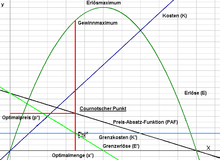Cost function (economy)


In economics, a cost function represents the relationship between costs and a reference value .
The first derivative of the cost function is called marginal costs .
Types of cost functions
Depending on their course, the following cost functions are distinguished:
- proportional (linear)
- The costs change in the same proportion as the reference quantity. The unit costs then remain constant - regardless of the reference quantity - and are identical to the marginal costs.
- degressive (disproportionately low)
- The costs increase more slowly as the reference quantity increases. The unit costs therefore decrease as the output volume increases. This can e.g. B. are due to discounts that are granted in the event of high quantities. Another example would be that the production time decreases due to a learning curve effect, i.e. H. the third pc produced is manufactured faster than the first.
- progressive (disproportionate)
- The costs increase more with increasing reference quantity. The unit costs increase (e.g. due to overtime ).
- regressive (decreasing)
- The costs and their unit costs decrease as the reference quantity increases (e.g. heating costs in event rooms when the number of visitors increases).
- fix
- The costs remain constant regardless of the value of the reference value. The unit cost function is degressive (see also fixed cost degression ). The marginal cost is 0.
- sprungfix
- The costs remain constant at certain intervals of the reference quantity. Between these intervals the costs “jump” to another level. The cost function assumes a stair-like course .
Reciprocal
The graph runs in an RL-turning curve (reciprocal "s-shaped" / degressive-progressive function) and is a non-linear cost curve as in the picture of the same name (black graph)
overview
| course | general form | example | Marginal cost | Unit cost |
|---|---|---|---|---|
| proportional | ||||
| degressive | ||||
| progressive | ||||
| regressive | ||||
| fix | ||||
| sprungfix | , in the jump points |
The following applies here
- : Cost function
- : Reference quantity
- and : constants. This also applies to degressive costs .
Explanation of the graphic non-linear cost curve
The total average costs initially decrease because the increased production brings cost advantages. The quantity quantification should best be interpreted as output per unit of time . This could explain why the total average costs temporarily rise again later: Because the production capacity limit is reached, an expansion investment is required, the costs of which are allocated to the total average costs. The fact that the marginal cost curve intersects the average cost curves at their minimum is explained by the fact that as long as the cost increase of the last unit is smaller than the average cost of all previous units, this increase is the average of all previous increases in which it is included presses. As soon as GK = DK, the average can no longer be pressed and will then be increased in the future.
See also
Web links
Individual proof
- ^ PA Samuelson: Economics , Volume 2






























